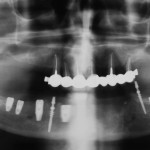
The use of dental implants is now relatively widespread and a wider range of formats are becoming available for different clinical situations. Early implants typically had a diameter of 3.75-4mm and with a length of 7-20mm. Bone resorption in the posterior jaw following tooth loss reduces available bone and decreases the proximity to the inferior alveolar bundle and maxillary sinus. While bone grafting and sinus lifting can improve the available bone height they are not without their complications so shorter implants have been suggested as an alternative approach.
The aim of this review was to evaluate the survival rate of short implants (equal or less than 8 mm) compared to standard implants (larger than 8 mm) in the posterior jaws.
Methods
Searches were conducted in the PubMed/Medline, Embase, and Cochrane Library databases. This was supplemented by hand searches of the journals; Clinical Implant Dentistry and Related Research, Clinical Oral Implants Research, International Journal of Oral and Maxillofacial Implants, International Journal of Oral and Maxillofacial Surgery, Journal of Clinical Periodontology, Journal of Dentistry, Journal of Oral and Maxillofacial Surgery, Journal of Oral Implantology, Journal of Oral Rehabilitation, Journal of Periodontology, Periodontology 2000.
Randomised controlled trials and prospective studies with at least ten patients published within last 10 years that compared short implants and standard implants and were published in English were considered. Data was abstracted by a single reviewer and checked by second with methodological quality being assessed using the Jadad Scale and the Cochrane risk of bias tool. Implant survival rates, complications and prostheses failures were evaluated by risk ratio (RR) and marginal bone loss, the continuous outcome were evaluated by mean difference (MD) and the corresponding 95% confidence intervals.
Results
- 13 studies (10 RCTs, 3 prospective) were included.
- 1269 patients had 2631 implants placed (981 short & 1650 standard implants).
- All 10 RCTs were considered to be of high quality.
- Follow up ranged from 4 months to 5 years.
- 45 standard implants (2.72%) and 38 short implants (3.87%) failed.
- Random effect meta-analysis found no statistically significant difference between standard implants and short implants placed in the posterior regions RR =1.35 (95% CI; 0.82–2.22: P=0.24).
- 9 studies evaluated marginal bone loss no differences in marginal bone loss were observed
- Maxilla: MD = 0.19 (95% CI; 0.41 to 0.03: P = 0.09)
- Mandible: MD = 0.23 (95% CI; 0.76 to 0.30: P=0.39)
- 7 studies reported complications and although there were higher rates of complications for the standard implants, there was no significant difference from short implants RR= 0.54 (95% CI; 0.27–1.09: P = 0.08)
- There were also no significant difference in prosthesis failures between standard and short implants RR= 0.96 (95% CI: 0.44–2.09: P = 0.92)
Conclusions
The authors concluded
Short implants showed marginal bone loss, prosthesis failures and complication rates similar to standard implants, being considered a predictable treatment for posterior jaws, especially in cases that require complementary surgical procedures. However, short implants with length less than 8 mm (4–7 mm) should be used with caution because they present greater risks for implant failures when compared to standard implants.
Comments
This review has conducted a broad search for relevant studies although a restriction to those published in English may result in some studies being excluded. Individual study quality has been assessed using the Jadad scale an approach that is no longer recommended. Interestingly an overall summary using the Cochrane risk of bias tool has also being presented and it shows high risk of bias for some elements, which raised some questions regarding the categorisation of all the RCTs as being of high quality. Presenting the Cochrane risk of bias tool for each RCT would have been helpful and preferable to the use of the Jadad scale.
The review suggests no difference in outcomes between standard and short implants although it is also worth noting that only 4 of the studies had a follow up period of 5 years so this needs to be taken into consideration as it would be good to have longer term outcomes to assist decision making.
Links
Primary paper
Lemos CA, Ferro-Alves ML, Okamoto R, Mendonça MR, Pellizzer EP. Short dental implants versus standard dental implants placed in the posterior jaws: A systematic review and meta-analysis. J Dent. 2016 Apr;47:8-17. doi: 10.1016/j.jdent.2016.01.005. Epub 2016 Jan 19. Review. PubMed PMID: 26804969.
Other references
Original review protocol on PROSPERO

Short dental implants show similar outcomes to standard implants in short term https://t.co/u75BXGovPZ
Short dental implants show similar outcomes to standard implants in short term: @TheDentalElf looks at the evidence https://t.co/YHSJapHQjr
Is survival of short dental implants similar to standard implants? https://t.co/u75BXGovPZ
Short implants had marginal bone loss, prosthesis failures and complication rates similar to standard implants https://t.co/u75BXGovPZ
Do short dental implants have similar outcomes to standard implants? https://t.co/u75BXGovPZ
Don’t miss – Short dental implants show similar outcomes to standard implants in short term https://t.co/u75BXGovPZ